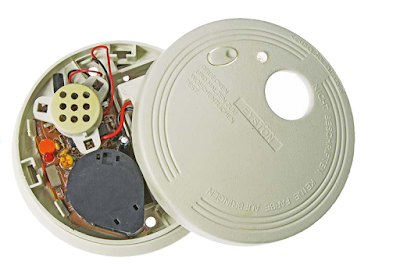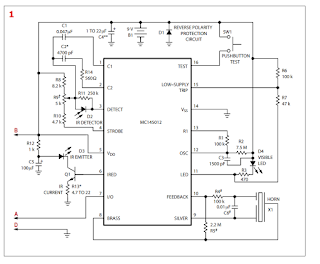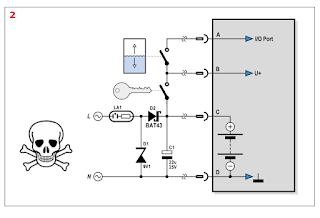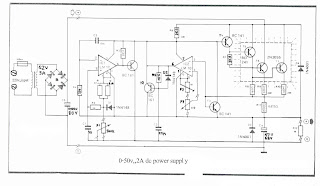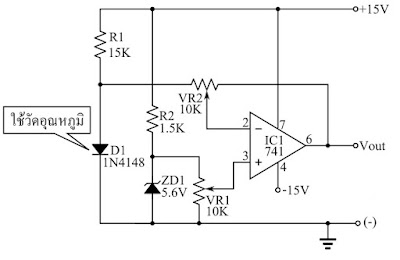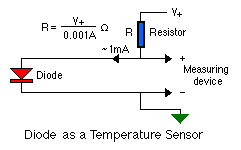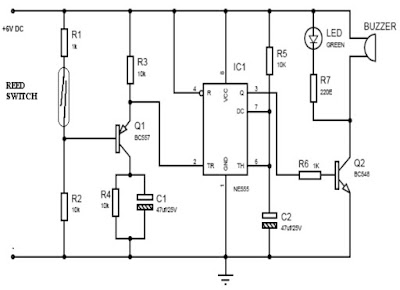Just add a few external components to a standard low-cost smoke alarm and turn it into a universal alarm sounder. You can easily hook up the outputs from any number of sensors or detectors to trigger the alarm and the smoke detector still functions as normal.
Down in our cellar we have a sump pump to automatically pump out any ground water that collects there. Should the pump fail and the water level start to rise, I need to know, before the cellar floods. The best solution is to ft a water level detector in the sump recess with its output connected to an alarm buzzer or sounder that can be heard throughout the house.
Waking the dead
I tried out a whole range of different alarm sounders to fnd the best solution. Mains powered horns are certainly loud enough but if the power goes down, so will the horn along with the pump. It is also easy to unintentionally blank-out this type of continuous alarm sound unless you are standing in the same room. For some inexplicable reason my brother, who likes to play tuba, wasn’t keen to take on the job of unpaid ‘alarm sounder’ on a permanent basis… The best solution I came up with is a plain vanilla smoke detector. The alarm sound is really penetrating and it works from battery power. Another nice feature is its built-in battery voltage level alarm. The detector is also quite cheap; the mini DIN plug and socket I bought from the electronics store for hooking up the sensor actually cost about the same as the complete smoke detector.
Every smoke detector I looked at uses a Freescale (previously Motorola) chip. Sometimes the chip type differs but they all have a ‘networked’ I/O pin 7 (Figure 1). This allows a number of smoke alarms to be linked together using a 2-wire bus so that when one alarm triggers, it sets off all the other alarms. As a stand alone smoke detector this network port is not used, but can of course be used as a general purpose alarm input. You won’t need to make any changes to the smoke detector circuit (or the test button) and the smoke detector will still work as normal.
The I/O pin7 has an internal pull-down resistor to ground. When the alarm is triggered this pin is pulled high and raises the bus to the positive supply voltage level. Input signals in the range of –0.25 V to VDD+10 V (this equates to +19 V for a 9 V PP3 type battery) are tolerated on this I/O. The switching threshold is +3.2 V. The MC145012 (and similar Chips) employ an internal current sink to give good immunity from interference. The LED D4 allows you to determine which smoke detector caused all the alarms to sound in a networked setup. Its LED will flash at half-second intervals while LEDs in all the other detectors remain off.
Incidentally it’s not a good idea to connect an external alarm signal to the test input pin 16. This input is not designed for the connection of long wires. When test is pressed it sets the smoke sensing circuit amplifcation to a maximum so that stray light in the smoke chamber is sufcient to trigger the alarm. This could also occur if interference or spikes are picked up by a long wire connected to this input pin. Apart from this, the pin only tests the smoke detection function, if the test is negative then the alarm won’t sound.
Warm beer alert
The smoke detector can be used as a general purpose alarm; it doesn’t matter if the high alarm signal is generated by a fridge door sensor, a beer cooler over-temperature detector or by an intruder alarm. You can connect the high-going output from all sorts of sensors (within the defned limits) to the ‘A’ input of the circuit shown in Figure 2. You can also combine the outputs from several detectors as a wired-OR input. As long as the voltage level on the ‘A’ input remains below 1.5 V then the alarm is not triggered. For the water level detector I used a float switch to drive this input high but there is no reason why you couldn’t use a transistor or more complex circuit to do the same job.
The float switch is actually a tilt switch, these days they don’t contain mercury but more environmentally acceptable steel balls rolling together to achieve the electrical contact. The switch should not trigger the alarm when any water is present in the sump. It needs to switch when the water rises above the danger level (above the pump but before it flows into the cellar). For this switching to occur reliably you need a mechanism or arrangement that allows free movement of the float. Here you can experiment to your hearts content, you can use a tube and cable ties or make use of a counterweight. With this set up its important that the counterweight is heavy enough to overcome the float buoyancy and make sure the weight or cable cannot slip. The free end between the weight and float should not be too short otherwise cable stiffness may hinder movement.
The smoke detector circuit shown in Figure 1 is taken from a Motorola application and was used in the smoke detector shown (with R13 = 6.8 ohms).
A risky supply
The circuit in Figure 2 shows a simple mains-powered charger to keep a rechargeable NiMH battery fully charged. The neon lamp LA1 is an E10 indicator lamp with a built-in series resistor giving a current flow of 1.5 to 1.9 mA at 230 V. The low level of charge current is just suffcient to compensate for self-discharge in the battery and can never overcharge it. The lamp indicates mains power is available (the alarm doesn’t need it but the pump does). The Zener diode D1 produces a low DC voltage and conducts in both directions so that the lamp is not dimmed. D2 prevents the battery discharging through D1. C1 is used as a reservoir capacitor and is effectively in parallel with capacitor C4 on the detector PCB. Diode D1 on the detector board protects against reversed battery connection and doesn’t otherwise interfere with circuit operation.
The value of C1 should not be made any larger otherwise it disrupts the battery check function of the alarm: Every 30 s the chip pulls down the LED output on pin 11 for around 8 ms and measures the battery voltage level at the input from the divider network R6 and R7 (a test under load). A larger capacitor with more stored charge will give a false confdence level of the remaining battery capacity; the detector will now only discover too late there is insufcient energy in the battery to sound the horn.
The charging circuit is really simple but also potentially lethal! There is no galvanic isolation from the AC line and it must not be used if you are able to accidentally touch any part of the circuit. Any external components like the key switch, sensor and wiring must be fully insulated. The charger design rules out the use of a sensor with bare wires to detect the rise of flood water.
The switch is used to turn off the water alarm, ideally use a key switch here so that it can’t be turned off by any unauthorized person. In one experiment I replaced the battery with a very large capacitor which was OK in normal operation but quickly ran out of charge when the alarm triggered. With the alarm installed I sleep more soundly, I know that if it sounds the cellar is on fre or is about to flood, either way, I will take a bucket.
read more...
Down in our cellar we have a sump pump to automatically pump out any ground water that collects there. Should the pump fail and the water level start to rise, I need to know, before the cellar floods. The best solution is to ft a water level detector in the sump recess with its output connected to an alarm buzzer or sounder that can be heard throughout the house.
Waking the dead
I tried out a whole range of different alarm sounders to fnd the best solution. Mains powered horns are certainly loud enough but if the power goes down, so will the horn along with the pump. It is also easy to unintentionally blank-out this type of continuous alarm sound unless you are standing in the same room. For some inexplicable reason my brother, who likes to play tuba, wasn’t keen to take on the job of unpaid ‘alarm sounder’ on a permanent basis… The best solution I came up with is a plain vanilla smoke detector. The alarm sound is really penetrating and it works from battery power. Another nice feature is its built-in battery voltage level alarm. The detector is also quite cheap; the mini DIN plug and socket I bought from the electronics store for hooking up the sensor actually cost about the same as the complete smoke detector.
Every smoke detector I looked at uses a Freescale (previously Motorola) chip. Sometimes the chip type differs but they all have a ‘networked’ I/O pin 7 (Figure 1). This allows a number of smoke alarms to be linked together using a 2-wire bus so that when one alarm triggers, it sets off all the other alarms. As a stand alone smoke detector this network port is not used, but can of course be used as a general purpose alarm input. You won’t need to make any changes to the smoke detector circuit (or the test button) and the smoke detector will still work as normal.
The I/O pin7 has an internal pull-down resistor to ground. When the alarm is triggered this pin is pulled high and raises the bus to the positive supply voltage level. Input signals in the range of –0.25 V to VDD+10 V (this equates to +19 V for a 9 V PP3 type battery) are tolerated on this I/O. The switching threshold is +3.2 V. The MC145012 (and similar Chips) employ an internal current sink to give good immunity from interference. The LED D4 allows you to determine which smoke detector caused all the alarms to sound in a networked setup. Its LED will flash at half-second intervals while LEDs in all the other detectors remain off.
Incidentally it’s not a good idea to connect an external alarm signal to the test input pin 16. This input is not designed for the connection of long wires. When test is pressed it sets the smoke sensing circuit amplifcation to a maximum so that stray light in the smoke chamber is sufcient to trigger the alarm. This could also occur if interference or spikes are picked up by a long wire connected to this input pin. Apart from this, the pin only tests the smoke detection function, if the test is negative then the alarm won’t sound.
Warm beer alert
The smoke detector can be used as a general purpose alarm; it doesn’t matter if the high alarm signal is generated by a fridge door sensor, a beer cooler over-temperature detector or by an intruder alarm. You can connect the high-going output from all sorts of sensors (within the defned limits) to the ‘A’ input of the circuit shown in Figure 2. You can also combine the outputs from several detectors as a wired-OR input. As long as the voltage level on the ‘A’ input remains below 1.5 V then the alarm is not triggered. For the water level detector I used a float switch to drive this input high but there is no reason why you couldn’t use a transistor or more complex circuit to do the same job.
The float switch is actually a tilt switch, these days they don’t contain mercury but more environmentally acceptable steel balls rolling together to achieve the electrical contact. The switch should not trigger the alarm when any water is present in the sump. It needs to switch when the water rises above the danger level (above the pump but before it flows into the cellar). For this switching to occur reliably you need a mechanism or arrangement that allows free movement of the float. Here you can experiment to your hearts content, you can use a tube and cable ties or make use of a counterweight. With this set up its important that the counterweight is heavy enough to overcome the float buoyancy and make sure the weight or cable cannot slip. The free end between the weight and float should not be too short otherwise cable stiffness may hinder movement.
The smoke detector circuit shown in Figure 1 is taken from a Motorola application and was used in the smoke detector shown (with R13 = 6.8 ohms).
A risky supply
The circuit in Figure 2 shows a simple mains-powered charger to keep a rechargeable NiMH battery fully charged. The neon lamp LA1 is an E10 indicator lamp with a built-in series resistor giving a current flow of 1.5 to 1.9 mA at 230 V. The low level of charge current is just suffcient to compensate for self-discharge in the battery and can never overcharge it. The lamp indicates mains power is available (the alarm doesn’t need it but the pump does). The Zener diode D1 produces a low DC voltage and conducts in both directions so that the lamp is not dimmed. D2 prevents the battery discharging through D1. C1 is used as a reservoir capacitor and is effectively in parallel with capacitor C4 on the detector PCB. Diode D1 on the detector board protects against reversed battery connection and doesn’t otherwise interfere with circuit operation.
The value of C1 should not be made any larger otherwise it disrupts the battery check function of the alarm: Every 30 s the chip pulls down the LED output on pin 11 for around 8 ms and measures the battery voltage level at the input from the divider network R6 and R7 (a test under load). A larger capacitor with more stored charge will give a false confdence level of the remaining battery capacity; the detector will now only discover too late there is insufcient energy in the battery to sound the horn.
The charging circuit is really simple but also potentially lethal! There is no galvanic isolation from the AC line and it must not be used if you are able to accidentally touch any part of the circuit. Any external components like the key switch, sensor and wiring must be fully insulated. The charger design rules out the use of a sensor with bare wires to detect the rise of flood water.
The switch is used to turn off the water alarm, ideally use a key switch here so that it can’t be turned off by any unauthorized person. In one experiment I replaced the battery with a very large capacitor which was OK in normal operation but quickly ran out of charge when the alarm triggered. With the alarm installed I sleep more soundly, I know that if it sounds the cellar is on fre or is about to flood, either way, I will take a bucket.
Author by: Jürgen Friker (Germany) Copyright by: Elektor

